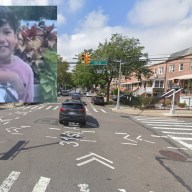By Patrick Donachie
The preferences of Queens voters mirrored city and statewide trends in the April 19 New York presidential primaries, with Hillary Clinton and Donald Trump claiming dominant victories throughout most of the borough.
Donald Trump handily bested his Republican rivals, according to an analysis from the Center for Urban Research at the CUNY Graduate Center that was based on unofficial city Board of Election returns from the night of the election. Trump won overwhelmingly in Middle Village, Howard Beach and throughout much of northeastern Queens.
Michael Krasner, a professor of political science at Queens College and the co-director of the Taft Institute for Government, said the Republican results were expected in the context of Trump’s appeal with white working-class Republicans who desire a “strong leader” and who view illegal immigration and shifting social changes with trepidation.
“They want someone who is going to cut through red tape and procedure and just get things done,” he said. “And that’s what Trump promises to do.”
Krasner also speculated that Queens native Trump enjoyed a hometown advantage from being so closely associated with the city, and said U.S. Sen. Ted Cruz (R-Texas)likely damaged his chances in New York when he criticized “New York values” during a Jan. 14 presidential debate.
Krasner said the Democratic contest also reflected national trends. U.S. Sen. Bernie Sanders, an Independent running as a Democrat, won in areas like Ridgewood, Astoria and Middle Village, which have large concentrations of white, younger working-class voters. Clinton prevailed in northeastern Queens neighborhoods with sizable percentages of older voters, as well as in areas like Jamaica, St. Albans and Queens Village that had higher rates of African-American voters.
“Clinton has had from the beginning a substantial advantage in African-American communities,” Krasner said, and noted that her prominence on the national stage worked to her advantage with older voters. “She’s a more familiar candidate than Bernie. It’s been hard for him to make a dent with people who have a long acquaintance with Clinton.”
Krasner said while New York state’s closed primary system likely hurt Sanders’ chances because independents were unable to vote for him, he had still expected Sanders to capture liberal enclaves throughout the city that eventually went to Clinton, including the West Village and the Upper West Side in Manhattan. He speculated that Sanders’ stances on gun control may have hurt him with city liberals.
Registered Democrats in Queens vastly outnumber other parties, according to state Board of Elections data. According to the BOE, Queens had 722,740 registered Democrats as of April 1, as opposed to 123,479 registered Republicans and 27,796 registered Independents.
In 2016, 28,549 votes were cast in the Republican presidential primary in Queens, according to unofficial vote tallies from the BOE. In the 2012 Republican presidential primary, only 7,217 votes were cast, according to certified BOE data. President Barack Obama ran unopposed on the Democratic line in 2012.
On average, 33 percent of registered Democrats and 26 percent of registered Republicans in the city voted in the 2016 primary, according to the CUNY analysis.
A spokeswoman from the League for Women Voters said turnout in the primary had surpassed expectations.
Reach reporter Patrick Donachie by e-mail at pdona

































